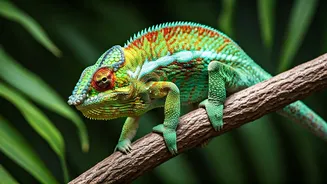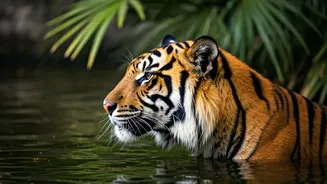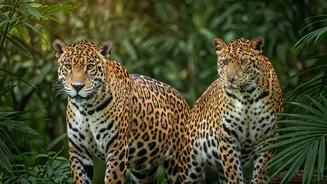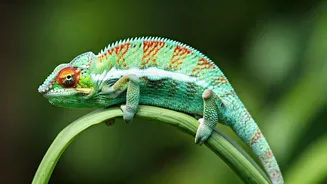The Colour-Changing Wonders
Colour-changing animals have captivated humans for centuries, demonstrating an extraordinary adaptation to their environments. The most famous of these
is undoubtedly the chameleon, celebrated for its ability to shift hues. However, a wide range of other creatures also employ this impressive skill. These colour changes are not mere aesthetic shifts; they are a sophisticated mechanism for survival, enabling camouflage, communication, and even temperature regulation. The underlying science involves specialized cells called chromatophores, which contain pigments or reflective structures that can be manipulated to alter the animal's appearance. The process is not always instantaneous, and the colours displayed depend on factors like mood, environment, and physiological state. The ability to blend seamlessly into surroundings provides a significant advantage in predator avoidance and prey capture.
Chameleon's Remarkable Camouflage
Chameleons represent the pinnacle of colour-changing adaptation, particularly among reptiles. These fascinating creatures are not limited to matching their surroundings passively, but instead actively control their colours. Different species of chameleons can display an astounding palette of hues, including greens, browns, yellows, and blues. The colour change is determined by a complex interplay of environmental factors, social signals, and even their emotional state. Contrary to a common misconception, chameleons do not simply change colour to blend into their immediate surroundings; instead, the process serves multiple functions. Camouflage, temperature regulation, and social communication are all crucial. In warmer conditions, chameleons can darken to absorb more heat, whereas, in cooler environments, they lighten to retain heat. During mating displays or territorial disputes, vibrant colours are often deployed to communicate intentions. The chameleon's ability to undergo such transformations is possible due to specialised cells called iridophores.
Octopuses: Masters of Disguise
Octopuses showcase an even more impressive colour-changing ability. These intelligent cephalopods use their skin to blend seamlessly into their surroundings with astonishing speed and precision. Unlike chameleons, octopuses can change the texture of their skin to mimic the surface they are on. This includes various surface textures, such as rocks, sand, and coral. The octopus's chromatophores allow rapid colour alteration and are controlled directly by the nervous system, enabling instantaneous changes in appearance. Beyond camouflage, colour is used in courtship rituals, communication with other octopuses, and even in startling displays to ward off predators. The octopus's ability to blend in with its environment is an advanced adaptation that helps them hunt prey and avoid becoming prey themselves. This rapid colour change is critical to their survival in a vast and varied aquatic world.
Cuttlefish: Quick Change Artists
Cuttlefish, closely related to octopuses, are known for their remarkable colour-changing abilities. They possess chromatophores similar to octopuses but also have iridophores and leucophores, which create iridescent and reflective effects, greatly expanding their range of visual capabilities. The cuttlefish uses its ability to display a wide variety of colours, patterns, and even textures, which allows for instant blending with its environment. This ability serves multiple purposes, including camouflage for protection, attracting prey, and communication with other cuttlefish. Cuttlefish can change their appearance in a fraction of a second, which enables quick adaptation to diverse underwater terrains. These fast colour shifts, combined with their ability to alter skin texture, make the cuttlefish a truly sophisticated creature.
Flatfish: Camouflage Champions
Flatfish, like flounder and sole, are another group of marine animals skilled at camouflage. Their unique body shape, flattened horizontally, allows them to lie on the seafloor. They have developed an efficient means of changing their colour and patterns to match their surroundings. This ability provides them with significant advantages in both hunting and protection. The flatfish employs chromatophores to control their colour, matching the colours and patterns of the seabed to such an extent that they often become nearly invisible. Their camouflage helps them ambush prey or evade predators, allowing them to remain well-hidden. The flatfish can adjust their appearance to blend seamlessly with sand, rocks, or other features of the seafloor, making them one of the most remarkable examples of natural camouflage.
The Colourful Squid Species
Several species of squid demonstrate outstanding colour-changing abilities that serve both camouflage and communication purposes. Similar to octopuses and cuttlefish, squids utilize chromatophores, iridophores, and leucophores in their skin to create various colours and patterns. Some squids use bioluminescent organs, which enhance their ability to create patterns in response to light. These abilities assist them in camouflaging, communicating with other squids, and attracting potential mates. The rapid and complex colour changes enable them to adapt quickly to different environments and social situations. Different squid species use their colour-changing skills uniquely, displaying flashes of colour to signal their intentions during mating or to ward off competitors. The behaviour demonstrates the diversity and complexity of adaptation within the cephalopod group.





